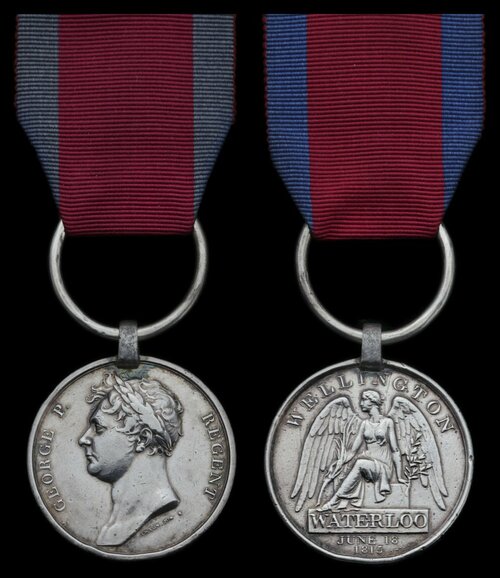
Auction: 21003 - Orders, Decorations and Medals
Lot: 9
Waterloo 1815 (James Nunn. 1st Batt. 4th Reg. Foot.), contact marks very fine
Provenance:
Glendining's, June 1908.
James Nunn was born at Hepworth, Suffolk in 1794 and joined the 4th Foot at Bury St Edmunds on 24 August 1812.
On 4 May 1814, following Napoleon's abdication, the 1st Battalion, 4th Foot joined a Royal Navy convoy at Garonne and were transported across the Atlantic, participating in Major-General Ross's victory at Bladensburg on 24 August. With just over 4,000 men, Ross defeated an American force twice that size. The battle-hardened 4th Foot managed to outflank the U.S. Marines, taking over 100 prisoners and capturing ten guns. Had it not been for this manoeuvre, the British would have suffered far higher casualties in a frontal assault. 'Bladensburg' became a regimental Battle Honour. The Americans, including President Madison, fled in panic after putting up very little resistance. This retreat, forever known as 'The Bladensburg Races', has been described by an American historian as 'the greatest disgrace ever dealt to American arms,' and 'the most humiliating episode in American history' (Howe 2006, 67).
Entering Washington, just 8 miles away, Ross and his officers enjoyed a civilised dinner in the White House before setting it aflame. Numerous other government buildings were torched in retaliation for the American damage to York in Upper Canada the previous year. A heavy storm then saved the city, and within 24 hours the British had returned to their ships. General Packenham's needless assault on New Orleans, on 8 January 1815, was rather less successful. The 4th Foot were in the front line, almost reaching the Rodriguez Canal before withering American fire forced them to withdraw. The assault took place after peace had already been concluded with the United States under the Treaty of Ghent; the news had not yet reached the combatants.
The 4th Foot were still in America when Napoleon escaped from Elba. They were rushed across the Atlantic, arriving at Ostend on 15 June 1815. After a determined 48-hour march, they arrived at Waterloo just in time to influence the battle. The 4th reinforced Wellington's beleaguered centre at 6 p.m., when La Haye Sainte had fallen and it looked as if Napoleon might clinch victory. When the Imperial Guard recoiled at 8 p.m., the 4th Foot swept forward and retook La Haye Sainte. The Allied pursuit did not stop until Paris was reached. To commemorate the Regiment's performance at Waterloo, a laurel wreath was added to its insignia. Nunn served at Waterloo in Captain Craig's Company No. 5 and served in the West Indies from 5 April 1819-4 April 1826. He was discharged on 24 August 1827 'weak and sickly and a bar marcher'. His conduct was 'bad' and he was also noted as having been once wounded, perhaps in North America and retired in Wangford; sold together with copied research.
Subject to 20% VAT on Buyer’s Premium. For more information please view Terms and Conditions for Buyers.
Sold for
£2,600
Starting price
£1100




